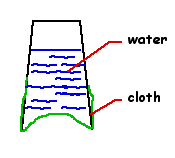|
| Materials: |
| · |
a
drinking glass |
| · |
a
piece of cheese cloth (or any other thin cloth) large enough
to cover the mouth of the glass |
|
 |
| Procedure: |
| 1. |
Fill
the glass 3/4 full of water |
| 2. |
Wet the
cloth under the tap (water should be seen to flow easily through
the cloth) |
| 3. |
Place
the cloth over the mouth of the glass and push the fringes against
the side of the glass. |
| 4. |
Hold the fringes with
one hand against the glass; with the other hand hold the bottom
part of the glass without holding the cloth and invert. (Turn
it upside down... doing this over a sink might be wise!) |
| 5. |
Let go
of the first hand. The cloth will stay attached and the water
will stay in the glass. |
|
| Try
This: |
| |
Push a pencil through
the cloth on the inverted glass of water without emptying the
water from glass? |
|
| Explanation: |
| |
The cloth needed to
be wet with water so that it could adhere to the sides of the
glass (adhesive forces between water and cloth, and water and
glass). During the process of inverting, some water poured out,
because the cloth is porous, causing an increase in the air pocket
volume above the water, which in turn reduced the pressure inside
the glass. This activity is also representative of the cohesive
forces between water molecules, as a film of water molecules
is formed in the little pores of the cloth. |
|
| Follow-up: |
| 1. |
Why does
the wet cloth cling to the sides of the glass? |
| 2. |
Explain
why some water flows out of the glass in the beginning. |
| 3. |
Why does
the water stop flowing out? |
| 4. |
What
is keeping the water and the cloth up? |
| 5. |
Can we
hold the glass at a slant or sideways without letting the water
flow out? |
| 6. |
What
shape does the cloth take when we hold the glass vertically upside
down? Why? |
|
|
Obtaining credit for your
efforts
- Print a copy of the blank laboratory write-up
paper.
- Read and complete each section, incomplete
write-ups receive no credit.
- Have your parent check your work and sign
the paper.

|
|
